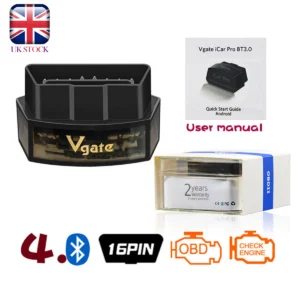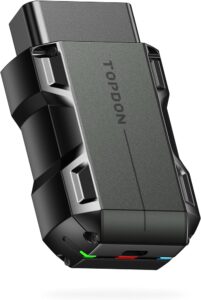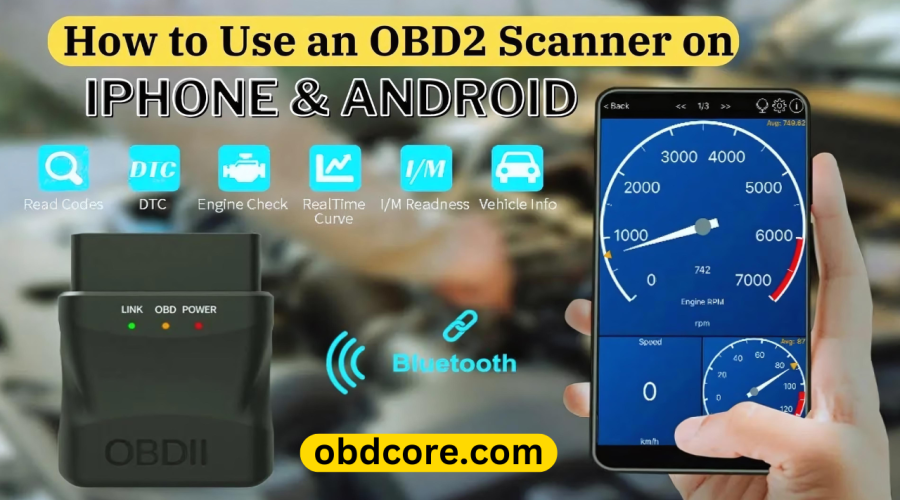How to Use an OBD2 Scanner with Your iPhone or Android
To use an OBD2 scanner with your iPhone or Android device, first download a compatible app. Next, connect the scanner to your car’s OBD2 port and pair it with your smartphone via Bluetooth or Wi-Fi. Car maintenance has evolved with technology, and one of the handiest tools for vehicle diagnostics is the OBD2 (On-Board Diagnostics II) scanner. This small device, when synced with a smartphone, opens up a world of real-time information about your car’s performance and potential issues .This guide will briefly explain the steps you need to take to get started, ensuring even a novice can confidently use this technology to keep their car in check.Introduction To Obd2 Scanners
Rise Of Diy Car Diagnostics
DIY car diagnostics has grown. People want to understand car problems themselves. OBD2 scanners are helpful for this need. The scanners connect to the OBD2 port in the car. Then, they read codes sent by the car’s computer. These codes tell you if there is a problem. With an OBD2 scanner, you don’t always need a mechanic.Compatibility With Smartphones
OBD2 scanners now work with smartphones. This makes them easier to use. Both iPhone and Android phones can connect to these scanners. You need to have the right app. The scanner sends car data to your phone through Bluetooth or Wi-Fi. This way, you can see car information on your phone’s screen. It’s very useful for quick checks.Essentials Before You Start
Selecting The Right Obd2 Scanner
Not all OBD2 scanners are created equal. Compatibility with your device is crucial. Consider the following points:- Look for scanners with iOS or Android support, depending on your device.
- Check for wireless capabilities like Bluetooth or WiFi for seamless connectivity.
- Read reviews to gauge user experience and ease of use.
- Ensure the scanner app features meet your needs, whether for basic data or advanced diagnostics.
Understanding Your Vehicle’s Protocol
Your vehicle communicates through a specific protocol. Identify this before pairing your scanner:| Protocol | Common Vehicles |
|---|---|
| SAE J1850 PWM | Mostly Ford vehicles |
| SAE J1850 VPW | General Motors vehicles |
| ISO9141-2 | Chrysler, European, and Asian vehicles |
| ISO 14230-4 (KWP2000) | Post-2003 vehicles |
| ISO 15765-4 (CAN) | Vehicles from 2008 onwards |
Setting Up The Obd2 Scanner
Step-by-step Connection Process
- Locate your vehicle’s OBD2 port, usually found beneath the dashboard on the driver’s side.
- Plug the OBD2 Scanner into the port. Make sure the connection is secure.
- Turn on your vehicle’s ignition to power the OBD2 scanner.
- Download a compatible OBD2 app for your iPhone or Android device.
- Open the app and navigate to the ‘Settings’ or ‘Connections’ menu.
- Choose the option to ‘Connect to OBD2’ or similar.
- If asked, select the type of connection, such as
BluetoothorWi-Fi. - Follow the app prompts to pair your device with the OBD2 Scanner.
- Confirm the connection is active. You should see data from your car’s computer.
Troubleshooting Common Setup Issues
- Issue: Scanner won’t connect.
- Solution: Check if the scanner is properly inserted into the OBD2 port.
- Issue: App doesn’t find the scanner.
- Solution: Ensure Bluetooth or Wi-Fi is enabled on your device.
- Issue: Connection is frequently lost.
- Solution: Verify that your vehicle’s ignition is turned on.
- Issue: Data isn’t showing in the app.
- Solution: Re-pair the device or restart the app.
- Issue: Pairing is unsuccessful.
- Solution: Confirm the pairing code matches if required.
Choosing The Correct App For Your Device
Unlock the power of your car’s data with an OBD2 scanner app for your iPhone or Android device. These apps transform your phone into a diagnostic powerhouse. Before jumping in, it’s vital to pair your vehicle with a compatible app. This ensures you get accurate information and a user-friendly experience. Consider factors like features, ease of use, and interface quality. Support for your specific vehicle model is also crucial.Top Apps For Iphone Users
iPhone owners have several exceptional OBD2 scanner apps at their fingertips. Look for apps with positive reviews and robust functionality. A popular choice is ‘OBD Auto Doctor’. It’s known for its sleek interface and comprehensive diagnostics.’Car Scanner ELM OBD2‘ is another favorite. It offers customizable dashboards and real-time data tracking. ‘EOBD Facile’ rounds out the list with its straightforward approach and VIN recognition capacity.| App Name | Features | User Rating |
|---|---|---|
| OBD Auto Doctor | Comprehensive diagnostics, sleek interface | 4.5/5 |
| Car Scanner ELM OBD2 | Customizable dashboards, real-time data | 4.7/5 |
| EOBD Facile | VIN recognition, user-friendly | 4.3/5 |
Best Choices For Android Users
Android users also benefit from a wide array of quality OBD2 apps. ‘Torque Pro’ stands out with its detailed logging capabilities and wide support for different cars. ‘OBDLink’ is also a strong contender with its fast performance and developer’s commitment to regular updates. Lastly, ‘Piston’ is perfect for beginners seeking a clear interface and essential features without complexity.- Torque Pro – Advanced logging, supports many vehicles
- OBDLink – Fast performance, regular updates
- Piston – Clear interface, essential features
Pairing Your Obd2 Scanner With Your Smartphone
Unlock the full potential of your vehicle’s diagnostics right from your smartphone using an OBD2 scanner. Simple steps guide you through connecting devices seamlessly.
Bluetooth Pairing For Android
For Android users, pairing with a Bluetooth OBD2 scanner is a quick process:- Enable Bluetooth on your Android device.
- Plug the OBD2 scanner into the vehicle’s OBD port.
- Open your Bluetooth settings and search for new devices.
- Select the OBD2 scanner from the list of available devices.
- Input the pairing code if prompted — often ‘1234’ or ‘0000’.
Wi-fi Connection Setup For Iphone
iPhone users can connect to a Wi-Fi OBD2 scanner with these steps:- Insert the OBD2 scanner into the car’s diagnostic port.
- In your iPhone’s Wi-Fi settings, connect to the scanner’s network.
- Enter the provided password if required.
- Launch your OBD2 scanning app and begin diagnostics.
Navigating The App Interface
Discovering how to navigate your OBD2 app on iPhone and Android is straightforward. First, connect your OBD2 Bluetooth scanner to your vehicle. Open your chosen OBD2 app. The app interface greets you with real-time data from your car. Today’s focus is on easing through that interface efficiently.
Understanding Data Display And Codes
Once the OBD2 scanner pairs with your app, information appears on your screen.- Data readings: Speed, temperature, and more show in clear, real-time graphics.
- Trouble codes: These alphanumeric codes indicate issues your car might have.
- Code meanings: The app offers explanations for each code, keeping you informed.
Customizing App Settings
Personalization makes the app work better for you.- Access the settings menu in your app.
- Adjust the units of measure (like miles to kilometers).
- Toggle notifications for regular updates on your car’s status.
- Choose which data parameters to display for a custom overview.
Interpreting The Diagnostic Information
Have you ever been puzzled by the lights on your car’s dashboard? An OBD2 (On-board Diagnostics) scanner can communicate with your vehicle’s computer system to explain these signals. Both iPhone and Android users can easily decode these messages with the right app and scanner tool. Here’s how to make sense of that information.
Decoding Check Engine Lights
When your check engine light turns on, it’s time to consult your OBD2 scanner. Connect the scanner to your car’s diagnostic port and sync it with your smartphone. The app will show a trouble code that pinpoints the issue. Focus on these steps:- Launch the OBD2 app on your smartphone.
- View the alphanumeric codes displayed.
- Search within the app or online for code definitions.
Monitoring Real-time Performance Data
Understanding performance as you drive is crucial. OBD2 scanners deliver real-time data on various parameters. Look at RPM, speed, and fuel efficiency. This is how to monitor effectively:- Connect your scanner and start the engine.
- Observe the live data on your smartphone app.
| Parameter | What It Tells You |
|---|---|
| RPM | Engine speed |
| Temperature | Engine and coolant temperature |
| Oxygen Sensor | Fuel mixture efficiency |

Taking Action On Diagnostic Results
After using an OBD2 scanner on iPhone or Android, it’s crucial to understand the diagnostic results. Acting on these results promptly ensures vehicle health and safety. Let’s discuss the steps following the scan diagnosis.
When To Diy And When To Call A Pro
Decoding car trouble codes can be tricky. Knowing when to handle repairs yourself or seek professional help saves time and money.- Simple issues like loose gas caps often have quick fixes.
- Dashboard warnings related to emissions are common DIY scenarios.
- Complex problems involving the engine or transmission warrant a professional mechanic’s expertise.
Clearing Codes And Turning Off Warning Lights
Warning lights on the dashboard can create stress. Once issues are resolved, these lights must be cleared to avoid confusion.- Connect the OBD2 scanner to your vehicle following the instructions.
- Locate the ‘Clear Codes’ or ‘Reset’ function on the scanner application.
- Confirm to clear the codes, which will turn off the warning lights.
Maintaining Your Obd2 Scanner
Keeping your OBD2 scanner in tip-top shape ensures you get reliable vehicle diagnostics every time you use it. Like any smart device, your OBD2 scanner requires regular attention. This includes software updates and proper physical care.
Proper care extends the life of your scanner. It ensures accurate and effective performance with each use.

Mastering the use of an OBD2 scanner with your iPhone or Android device unlocks incredible potentials. Delve into advanced functions like creating custom dashboards and sharing insightful data logs. Let’s explore these functionalities to maximize your vehicle diagnostics.
Regular Updates For Your App And Device
- Check for updates: Open your OBD2 app routinely to see if there are new updates available.
- Enable automatic updates: In your phone settings, turn on auto-update for your OBD2 app.
- Synchronize device firmware: Pair your scanner with your phone to ensure its firmware is current.
Keeping Your Scanner In Good Condition
| Tips | Details |
|---|---|
| Storage | Keep your scanner in a case. Avoid extreme temperatures and moisture. |
| Cleaning | Use a dry or slightly damp cloth. Do not use harsh chemicals. |
| Handling | Handle with care. Avoid dropping or placing heavy objects on the scanner. |
| Battery maintenance | For models with batteries, charge them regularly. Replace them as needed. |

Advanced Tips And Tricks
Creating Custom Dashboards
Custom dashboards transform data into a personalized experience. Begin with the basics.- Select the ‘Dashboard’ option in your OBD2 app.
- Choose ‘Edit’ or ‘Customize’ to start crafting your layout.
Exporting And Sharing Data Logs
Sharing data logs helps diagnose issues or track improvements over time. Here’s how to share your insights:- In the app, find the ‘Logs’ or ‘History’ section.
- Identify the relevant data log to share.
- Use the ‘Export’ function, usually found as a button or in a menu.
.csv for spreadsheets or .txt for notes. Send logs via email, or upload them to cloud storage for easy access. This feature aids in discussing vehicle issues with experts, tracking your car’s health over time, or even sharing findings with a community of enthusiasts.
Understanding The Limitations
Modern cars come with computer systems that talk to devices. An OBD2 scanner lets your iPhone or Android become a car doctor. But even doctors have limits. Let’s dive into what you should know before you start scanning.
Stay informed and understand limits to use scanners wisely. They are great tools, but knowledge and caution are your best friends.

Recognizing The Scope Of Diy Diagnostics
OBD2 scanners can provide a wide range of vehicle data and codes. Understanding the scope of DIY diagnostics is essential:- Basic info: Scanners can read car trouble codes.
- Limited advice: They may not tell how to fix an issue.
- Varied compatibility: Not all apps work with every car.
Legal And Warranty Considerations
Before you scan, know the legal and warranty factors. Automakers may have rules about who can mess with car computers. Tweaking the wrong setting might void a car’s warranty. Always check your car manual and warranty policies before scanning.| Action | Risk |
|---|---|
| Using scanner apps | Low |
| Making changes to car settings | High |
| Missing a serious problem | Variable |


